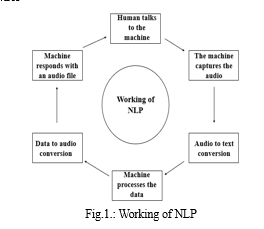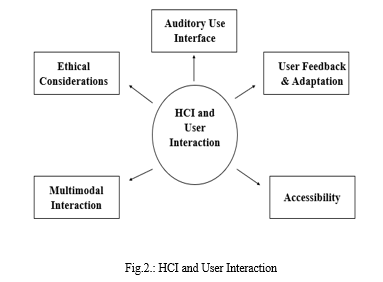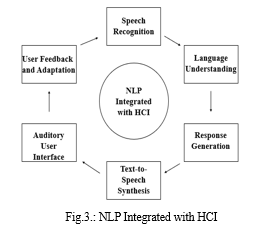Ijraset Journal For Research in Applied Science and Engineering Technology
- Home / Ijraset
- On This Page
- Abstract
- Introduction
- Conclusion
- References
- Copyright
NLP and Human-Computer Interaction: Enhancing User Experience through Language Technology
Authors: Rahul Kulkarni, Dr. Pradip Varade, Dr. R. G. Yellalwar
DOI Link: https://doi.org/10.22214/ijraset.2023.56219
Certificate: View Certificate
Abstract
Abstract: The interaction between humans and computers in our daily lives has become increasingly important in the age of ubiquitous digital technology. To rethink and improve the user experience, this research examines the complex area where Human-Computer Interaction (HCI) and Natural Language Processing (NLP) meet. Improved user experience, improved usability, and increased accessibility are all advantages of improved HCI. The value of NLP and ML in numerous disciplines is demonstrated through practical applications including chatbots, virtual assistants, and recommendation systems. This paper explores how NLP technology, in the context of a voice-activated virtual assistant, enriches HCI to create a more engaging and intuitive user experience.
Introduction
I. INTRODUCTION
In the evolving landscape of technology, the convergence of Natural Language Processing (NLP) and Human-Computer Interaction (HCI) has emerged as a vital junction, shaping the way humans engage with machines and digital interfaces. Here, the language technology power merges into an interactive interplay that enhances and streamlines the users’ experience. Natural Language Processing (NLP) has emerged as a revolutionary force, enabling computers to understand, interpret, and make humans speak. Since language is the primary form of human communication, it forms the basis for user-computer interaction. The promise of NLP is to facilitate more human-machine-like interactions while creating a technical model of human speech understanding. This allows computers to understand spoken and written texts, enabling natural conversations, text analysis, and emotional interpretation.
II. NATURAL LANGUAGE PROCESSING (NLP)
NLP, a part of AI and Linguistics, helps computers comprehend human written expressions or statements. NLP [1] is born as a result of desire to facilitate users’ efforts and fulfil the will to communicate with the computer using their native language. It takes care of this category of users who are constrained by time and cannot learn, for instance, to speak or write machine specific language perfectly.
A. NLP in Interactive Audio Responses

- Speech Input: When you speak to the machine, your speech is recorded as an audio input.
- Audio-to-Text Conversion: Natural Language Processing includes a component such as ASR that converts spoken words to text in ASR technology, when processing an audio input.
- Text Analysis: NLP algorithms then examine the modified text. These algorithms determine the word and sentence structure, grammar, and meaning in your input.
- Recognition of Intent: NLP algorithms attempt to determine your intent or the message you're trying to send. To assess the nature of your request or query, they may recognize keywords, context, and patterns.
- Response Generation: The NLP algorithms analyse the data and produce a response in the form of text that reflects the message the machine wants to convey.
- Text-to-Speech Conversion (TTS): Text-to-Speech technology (TTS) is now used to convert this text response into an audio file. The generated text is transformed into a natural-sounding auditory response via TTS.
- Audio Output: Then, it plays this audio back to you with the simulated voice of machine speaking back like humans.
B. Benefits of NLP
- Sentiment Analysis: NLP may assess public sentiment by analysing social media posts, reviews, and client comments. This can assist organizations in making fact-based decisions.
- Language Translation: NLP supports machine translation tools like Google Translate, dismantling language barriers and promoting intercultural understanding.
- Improved User Experience: NLP-powered chatbots, virtual assistants [2], and interfaces offer individualized and effective experiences that increase user pleasure.
- Effective Information Retrieval: NLP algorithms are able to quickly sort through enormous amounts of textual data to extract pertinent information, enhancing search engines and content recommendation systems.
III. HUMAN COMPUTER INTERACTION (HCI)
The concept of human computer interaction has emerged as a result of advancements in computer technology. Human-Computer Interaction (HCI) [3] is a multidisciplinary field that reflects the core of modern computing, focusing on designing and analysing user interfaces to facilitate seamless interactions among humans and between digital systems. As technology advances at an unprecedented pace these developments, HCI plays a key role in ensuring not only technological sophistication but ease of access for users. It blends principles of computer science, psychology, programming and process engineering to create computer experiences that meet human needs, preferences and cognitive processes.
A. HCI and User Interaction with Audio Responses

- Auditory User Interface: HCI concepts are used in the design of the auditory user interface to make sure that audio responses are understandable, succinct, and contextually appropriate.
- User Feedback and Adaptation: In order to enhance system performance, HCI entails gathering user feedback on the audio answers.
- Accessibility: Accessibility is a priority for HCI, and as a result, audio answers are inclusive and considerate to users with disabilities.
- Multimodal Interaction: HCI also includes multimodal interaction, which enables users to mix spoken language with touch, gestures, or visual clues for a comprehensive user experience.
- Ethical Considerations: The ethical design of audio answers is guided by HCI principles, which address concerns including user data handling for NLP-driven interactions, privacy, transparency, and permission.
B. Benefits of HCI
- Enhanced User Experience: HCI seeks to design intuitive, user-friendly, and interesting user interfaces. As a result, technology becomes more user-friendly and enjoyable for a wide range of individuals, enhancing the overall user experience.
- Improved efficiency: Well-designed HCI systems streamline tasks and procedures, resulting in increased productivity and output. Users can complete their tasks more quickly and with greater accuracy.
- Reducing Errors: The principles of HCI design focus on minimizing user errors by offering clear feedback, preventing unintended actions, and directing users towards correct interactions.
- Effective Communication: HCI plays a crucial role in designing interfaces that enable seamless and meaningful communication between users and computer systems. It ensures that users can easily convey their intentions to the system and receive relevant and understandable responses.
- Innovation: Human-Computer Interaction (HCI) fuels innovation by pushing the limits of how people engage with technology. It promotes experimentation with new interfaces and interaction approaches.
IV. SIGNIFICANCE OF ENHANCING HCI WITH NLP
Natural language processing (NLP) has been a significant field in human-computer interaction for over fifty years. It has made valuable contributions both in theory and practical applications. The integration of Natural Language Processing (NLP) [4] has brought about a significant transformation in the field of Human-Computer Interaction (HCI). This advancement allows machines to effortlessly comprehend and engage with human language. As computers become more affordable and accessible, the need for user-friendly interfaces that cater to users of all expertise levels becomes even more important. Natural language is known for its effortless and effective communication in human-human interactions, and its potential shouldn't be overlooked in human-computer interaction. Whether it's spoken or typed, natural language can complement other modalities like windows, icons, menus, and pointing devices. In some cases, such as with users who have disabilities, natural language may be the only applicable modality available.
A. NLP Integrated with HCI\

- Speech Recognition: It involves a spoken command from the user whereby he says Hey Assistant, read my schedule of today. The HCI in the case of a virtual assistant activates or switches on the microphone so as to be able to hear the user’s voice [10]. The transaction starts with speech recognition conversion of the spoken word into text through NLP.
- Language Understanding: Algorithms involved in NLP [5] take a look at the written content and determine some meanings of semantics and interpretations of the message by the user. The system is kept in context because queries build on previous communication. Hand in hand, HCI and NLP help the virtual aide understand that the user wants to access his/her daily schedule.
- Response Generation: The virtual assistant generates a user-centred reply through the fusion of the proficiency in natural language generation of NLP and the commitment to user-friendly design of HCI. The assistant responds, "Your schedule for today includes a meeting at 10 AM, followed by a lunch appointment at 12:30 PM." In line with the HCI guidelines on clear and brief responses, it focuses on the principles of effective communication.
- Text-to-Speech Synthes: The TTS synthesis converts the ‘text’ response into a voice. The TTS process is guided by HCI principles, to make sure that the audio response has right pacing and prosody in order to facilitate good communication.
- Auditory User Interface: The auditory user interface is designed based on HCI principles whereby ensuring that the audio response is understandable, hence user friendly and easy to use. Tone of voice and timing are other feedback components that comply with HCI guidelines on conductive users’ communication.
- User Feedback and Adaptation: After the response, the user feedback was harvested using HCI principles. This feedback is analysed by NLP which helps the system with adaptive interaction in future as well as improving language understanding and generating better responses.
V. FUTURE SCOPE
The convergence of NLP into HCI for virtual assistants could only lead to revolutionary future [6] in this field. With technology advancing, virtual assistants shall prove key company of everyone offering flawless, customized, intuitive interactive relationships; however, there is need to put up considerations that address issues of ethics and accessibility ensuring all individuals are benefited.
- Emotion recognition: Together, NLP and HCI will enable virtual assistants to recognize and react to users’ emotions [8]. This can lead to more interaction between empathic people and emotional intelligence.
- Advanced Natural Language Understanding (NLU): Continued improvements in NLP will make NLU [7] capabilities for virtual assistants even more accurate and context-sensitive. This includes a better understanding of the user’s thoughts, feelings, and nuances in speech.
- Personalization: Virtual assistants become more personalized, adapting to individual user preferences, behaviours, and even emotions. They offer personalized responses and services to deliver a truly personalized experience.
- Human-AI collaboration: The future is likely to see more human-assistant collaboration [9], especially in the workplace, where AI can enhance human capabilities and productivity.
Conclusion
In conclusion, as the interaction between humans and machines is constantly changing, NLP gets combined with HCI and appears as an important trend that is shaping up new technologies and human expectations or experiences. This essay has set out on a trip through this symbiotic relationship, showing the significant influence it has on how we communicate with digital systems. We have seen how NLP\\\\\\\'s language comprehension and HCI\\\\\\\'s user-centric design work together to create a symphony of improved user experiences via the lens of a voice-activated virtual assistant [2].
References
[1] Kai Jiang, Xi Lu (June 2023). “Natural Language Processing and Its Applications in Machine Translation: A Diachronic Review”. [2] Mathangi Sri (January 2021). “NLP in Virtual Assistants”. [3] Himanshu Bansal, Rizwan Khan (April 2018). “A Review Paper on Human Computer Interaction”. [4] Ali Haider, Danial Khan (June 2023). “Enhancing Human-Computer Interaction with Natural Language Processing and Machine Learning”. [5] Diksha Khurana, Aditya Koli, Kiran Khatter & Sukhdev Singh (July 2022). “Natural Language Processing: State of the Art, Current Trends and Challenges”. [6] M. Chandhana Surabhi (July 2013). “Natural language processing future”. [7] Alessandro Lenci (March 2023). “Understanding Natural Language Understanding Systems”. [8] Amit Pandey, Aman Gupta, Radhey Shyam (May 2022). “FACIAL EMOTION DETECTION AND RECOGNITION”. [9] Marigo Raftopoulos, Juho Hamari (April 2023). “HUMAN-AI COLLABORATION IN ORGANISATIONS: A LITERATURE REVIEW ON ENABLING VALUE CREATION [10] Horia-Alexandru Rusan, Bogdan Mocanu (November 2022). “Human-Computer Interaction Through Voice Commands Recognition”.
Copyright
Copyright © 2023 Rahul Kulkarni, Dr. Pradip Varade, Dr. R. G. Yellalwar. This is an open access article distributed under the Creative Commons Attribution License, which permits unrestricted use, distribution, and reproduction in any medium, provided the original work is properly cited.

Download Paper
Paper Id : IJRASET56219
Publish Date : 2023-10-19
ISSN : 2321-9653
Publisher Name : IJRASET
DOI Link : Click Here
 Submit Paper Online
Submit Paper Online

